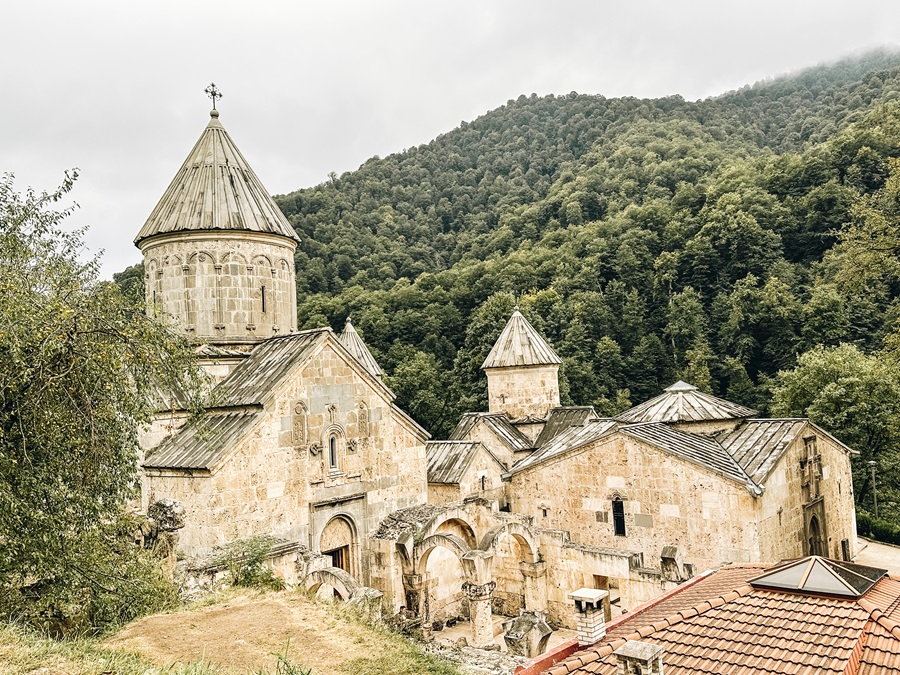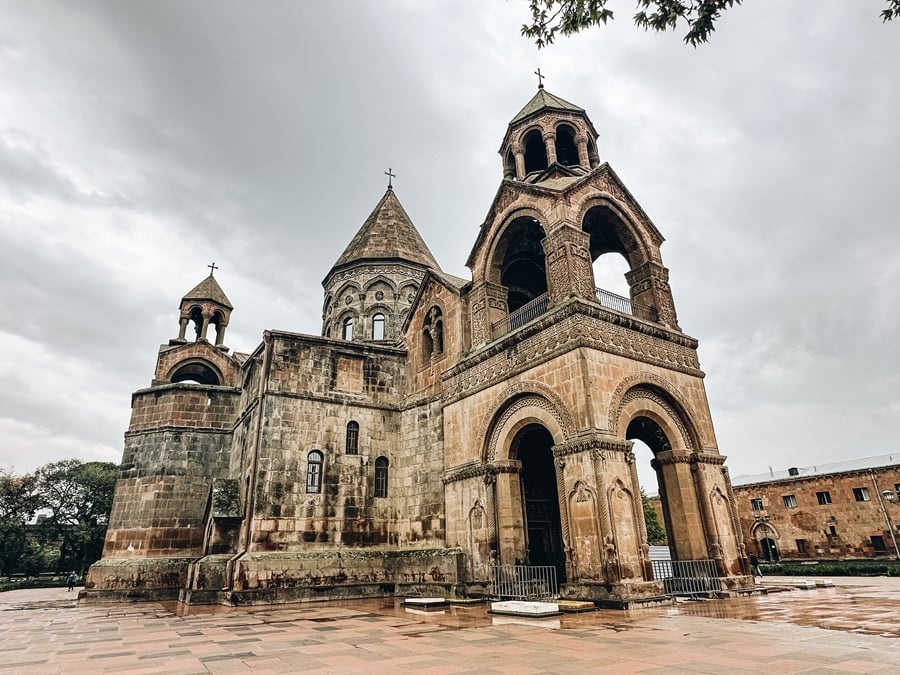Imagine stepping into this world where history isn’t just in books but lives and breathes through ancient stones. Armenia is such a place where time echoes through the ages and some of the top landmarks are proof of this. I got to witness many of these places on an Arara Tour of Caucasus.
One of their expert guides picked me up at the Georgian border and took me through the country on a historical tour. Many of the stops were temples, cathedrals and monasteries—each with their own beauty. These 8 were ones that are not-to-be-missed and on Arara’s 13-day Classical Tour of Azerbaijan, Georgia and Armenia I was taken to every one of them!
PS: They also have a 17-day tour for those who want a fuller coverage of the Caucasus region: Azerbaijan, Georgia and Armenia in 17-days.

The Best UNESCO and Other Historical Sites in Armenia
1. Goshavank Monastery
Located in the village of Gosh, Goshavank Monastery is a serene retreat. Founded by the scholar and cleric Mkhitar Gosh, this 12th-century complex boasts intricate khachkars (cross-stones) and stunning frescoes, making it a hidden gem for history enthusiasts.

One of the highlights of Goshavank is its Surb Astvatsatsin Church, an architectural masterpiece that displays a harmonious blend of stone and nature. The church’s façade is adorned with intricate carvings, telling stories of the era’s religious and historical significance.


2. Haghartsin Monastery
Nestled in the Dilijan National Park, Haghartsin Monastery is a true oasis of tranquility and architectural beauty. Dating back to the 13th century, this monastic complex is a testament to Armenia’s rich religious heritage and is set against the backdrop of lush forests and serene nature.

The location of Haghartsin is part of its allure. Surrounded by dense woods and enveloped in a calm, serene ambiance, it provides a sense of timelessness and peace. The complex comprises several structures, including the Surb Astvatsatsin Church and the Surb Grigor Chapel, each showcasing unique architectural elements that are a blend of Armenian ecclesiastical design and artistic flair.


3. Echmiadzin Cathedral
Often referred to as the “Vatican of Armenia,” Etchmiadzin Cathedral holds a profound place in the hearts of Armenians as the spiritual and religious center of the Armenian Apostolic Church.

Located in the city of Vagharshapat, this UNESCO site is not only a place of worship but also a repository of Armenia’s ancient religious heritage, with relics such as the Holy Lance and a piece said to be from Noah’s Ark.
Overall, this historic site stands as one of the most iconic landmarks in Armenia, preserving both the spiritual essence of the nation and its rich cultural heritage.


4. Zvartnots Temple Ruins
The Zvartnots Temple Ruins are a fascinating archaeological site that offers a window into Armenia’s architectural brilliance during the 7th century. Located near Vagharshapat, these ruins provide a glimpse into an era of innovation and artistic mastery.

The most striking feature of Zvartnots is its circular design, a departure from the typical cruciform plan of Armenian churches. While the temple itself may be in ruins, its historical significance is far from diminished. Zvartnots was once a major pilgrimage site and a hub of religious and cultural activity. It was even listed as a UNESCO World Heritage site, recognizing its historical and architectural importance.

5. Khor Virap Monastery
Standing majestically against the backdrop of Mount Ararat, Khor Virap Monastery is a revered site steeped in Armenian history and legend. According to legend, Gregory the Illuminator, the patron saint of Armenia, was imprisoned in a deep pit here for 13 years for preaching Christianity. The monastery’s name, which translates to “deep pit,” commemorates this event.


6. Noravank Monastery
Perched dramatically on a narrow gorge in Amaghu Canyon, Noravank Monastery is a masterpiece of Armenian architecture. Founded in the 12th century, the monastery is renowned for its intricate carvings and vibrant red stonework.
The monastery’s main church, Surb Astvatsatsin (Holy Mother of God), is a particularly stunning example of Armenian medieval architecture. With its soaring dome and elegant proportions, the church is a testament to the skill and dedication of the builders who created it.


7. Geghard Monastery
Partially carved into the cliffs of the Azat River Gorge, Geghard Monastery is a UNESCO World Heritage Site that is as captivating as it is unique. Founded in the 4th century, the monastery is said to have been built on the site of a sacred cave where the Spear of Longinus, the weapon used to pierce the side of Christ, was once kept. Its name, Geghard (which means “spear”,) is a reference to that.


Geghard Monastery is a standout among the historical landmarks in Armenia, with its rock-cut design being a testament to the ingenuity of Armenian architects, who utilized the natural landscape to create a unique and harmonious religious complex. The monastery’s main church, Katoghike, is a particularly impressive example of Armenian cave architecture, with its soaring columns and intricate carvings.


8. Garni Temple
A true marvel of ancient pagan Armenia, the Garni Temple stands as the country’s oldest and only surviving Hellenistic temple in the region. Dating back to the 1st century AD, the temple is dedicated to the Armenian sun god Mihr.
As you explore the site, you’ll notice not only the temple itself but also the remnants of a Roman bathhouse, a royal palace, and the exquisite mosaic floors that once adorned these structures. The mosaic floors are a vivid reflection of the artistic and cultural influences that shaped Armenia at the crossroads of various civilizations.

If you are a lover of historical sites, exploring Armenia’s historical landmarks is a must because it is evident that this nation’s story is etched in stone and faith. From the ‘Vatican of Armenia’ in Vagharshapat to the intriguing Zvartnots Temple Ruins, each site has shared a piece of the country’s rich history. And with just a few days in the country Arara Tours made it so easy to hit all of these conveniently, and safely.
Not only did they make the perfect itinerary, including booking comfortable hotels and providing excellent transportation, they had great guides who were knowledgeable in each area. This eas especially true for these pretty Armenia landmarks.
More Things to Do Near caucasus
Caucasus Tour: Azerbaijan, Georgia & Armenia Highlights
Georgian Food Bucket List: 43 Best Traditional Foods to Eat
